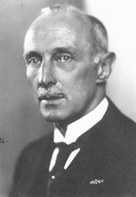Jan_van_der_Hoeve
Jan van der Hoeve
Dutch professor of ophthalmology
Jan van der Hoeve (13 April 1878 in Santpoort – 26 April 1952 in Leiden) was a Dutch ophthalmologist. He is recognised for his concept of the phakomatoses, often called neurocutaneous syndromes.
You can help expand this article with text translated from the corresponding article in German. (April 2022) Click [show] for important translation instructions.
|

Van der Hoeve graduated from the University of Leiden and received his doctorate at the University of Bern. He became a professor of ophthalmology at the University of Groningen and later at the University of Leiden. Van der Hoeve became a member of the Royal Netherlands Academy of Arts and Sciences in 1923.[1] He was elected president of the Physical Section of the institute in 1932.
Van der Hoeve made one of the earliest descriptions of Waardenburg syndrome, in 1916.[2]